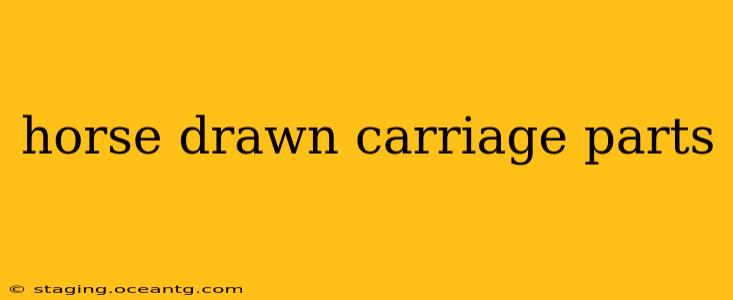Horse-drawn carriages, symbols of a bygone era, are intricate machines composed of numerous parts working in harmony. Understanding these components is crucial for enthusiasts, restorers, and anyone fascinated by the mechanics of these elegant vehicles. This guide delves into the key parts of a horse-drawn carriage, exploring their functions and significance.
What are the Main Parts of a Horse-Drawn Carriage?
A horse-drawn carriage, regardless of its specific style (e.g., buggy, phaeton, landau), shares a core set of essential components. These can be broadly categorized into:
- Chassis/Undercarriage: This forms the carriage's foundation, supporting the body and carrying the weight. Key elements include the axles, wheels, springs, and running gear.
- Body: This is the passenger compartment, offering protection from the elements and seating. Construction varies widely, from simple open designs to elaborate enclosed structures.
- Harness & Driving Gear: This encompasses the equipment used to control and connect the horses to the carriage. This includes the bridle, reins, shafts, traces, and other connecting elements.
What are the Different Types of Horse-Drawn Carriages?
The specific parts and their arrangement can vary significantly depending on the type of carriage. Some common types include:
- Buggy: Typically a two-wheeled, lightweight carriage, often with a single seat. Parts are generally simpler and less ornate than larger carriages.
- Phaeton: A four-wheeled carriage, often with a folding top and more elaborate features.
- Landau: A luxurious four-wheeled carriage with a removable top, allowing for both open and closed configurations.
- Victoria: A stylish, four-wheeled carriage, often with a curved dashboard and a folding top.
What are the Parts of a Horse-Drawn Carriage Wheel?
Carriage wheels, crucial for mobility, are complex components themselves. Key parts include:
- Spokes: Radial members connecting the hub to the rim.
- Rim: The outer edge of the wheel, holding the tire.
- Hub: The central part of the wheel, fitting onto the axle.
- Tire: The outer protective layer of the wheel, historically made of iron or wood, now often rubber.
How Do the Springs Work on a Horse-Drawn Carriage?
Springs are essential for providing a smoother ride, absorbing shocks and vibrations from the road. Different types of springs were used, including:
- Leaf Springs: Consisting of multiple layers of steel leaves, these were common in many carriages.
- C-Springs: These curved springs offered a different type of suspension.
What are the Different Types of Axles Used in Horse-Drawn Carriages?
Axles are critical for supporting the wheels and transmitting power. Different designs existed, with variations based on the carriage type and weight:
- Straight Axles: Simple, non-rotating axles.
- Elliptic Springs: Combined springs and axles offering a smoother ride.
Where Can I Find Parts for a Horse-Drawn Carriage?
Finding parts for horse-drawn carriages can require some research. Antique shops, restoration specialists, and online auction sites are good starting points. Specializing carriage builders may also provide parts or advice.
Conclusion
The world of horse-drawn carriage parts is rich and complex. Understanding the various components and their functions provides a deeper appreciation for the craftsmanship and engineering involved in these historical vehicles. Further research into specific carriage types will reveal even more nuanced details about their unique parts and construction.
